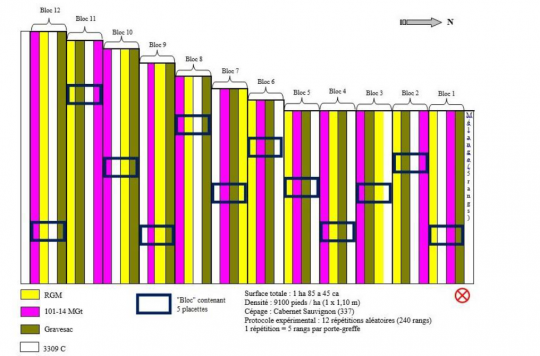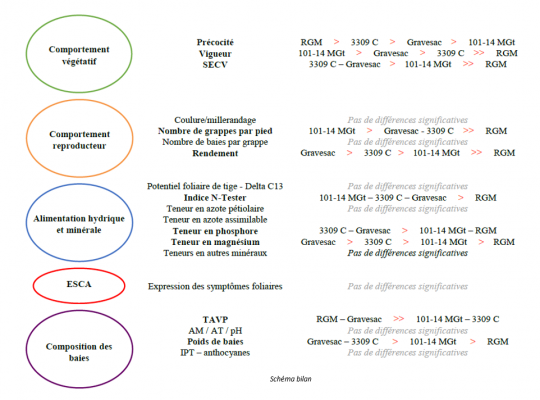Plant material is an integral part of the terroir and directly impacts the quality and quantity of production. The choice of rootstock is extremely important given its linking role between the soil and the plant so the decision is not always easy.
That's why we wanted to study the influence of the rootstalk on the performance of the Estate's emblematic grape variety, Cabernet Sauvignon. We started these rootstalk comparisons in 1999, but with the increased impact of climate change, further comparisons are planned between rootstocks that are better suited to current issues.
1.4.3.d Experiment results: Rootstalk comparisons
Method
The material was planted on the Grand Sablonnet 1 plot, which is also our massal selection reserve.
Planted in 1999 with Cabernet Sauvignon, this plot was organized to be able to compare the influence of 4 rootstocks, whilst taking into account the plot's soil heterogeneity. The 4 rootstocks studied are : Riparia Gloire de Montpellier (RGM), 3309 Couderc (3309C), Gravesac and the 101-14 Millardet et de Grasset (101-14 MGt).
Based on water and nitrogen regime maps, 4 separate trial blocks (1 block per rootstock) were positioned on the plot. Each trial block contains 5 vines.
Measures
| Measurements required for the GS1 comparison protocol |
|---|
| Pruning wood weighting |
| Determine the mid-flowering date |
| SECV measurement |
| Coulure and millerandage observations |
| Determining the mid-veraison date |
| ESCA monitoring |
| Yield estimates |
| N-Tester measurements |
| Water regime |
| Leaf potential of the base |
| Leaf potential of the stem |
| Delta C13 |
| Petiole analysis |
| Berries weighing |
| Maturation controls |
| Availible nitrogen |
The main results
Precocity: RGM gives the earliest flowering and veraison dates, followed by 3309 C, Gravesac and lastly 101-14 MGt
Vigor: significant discrepancies in vigor. RGM is not very vigorous and the rate of replacement for young roostalks remains higher.
Influence on leaf surface area: RGM is associated with a low leaf surface area, meaning that fewer grapes reach full maturity compared to other rootstocks.
Yield: RGM vines produced significantly lower clusters per vine compared to the three other rootstocks. The rootstock does not significantly influence the success of fruit set (coulure or millerandage).
Water and nitrogen supply: The plot's soil water supply is very uneven. RGM seems to restrict nitrogen supply compared to the other three rootstocks, but the plot's nitrogen supply highly variable.
Mineral nutrition: 101-14 MGt and RGM have difficulty absorbing phosphorus and RGM has difficulty absorbing magnesium. The block influences all mineral values, except magnesium. RMG is close to magnesium deficiency (see K/Mg ratio)
Influence on maturity: RGM and Gravesac engender an earlier overall ripeness with regards to sugar content.


